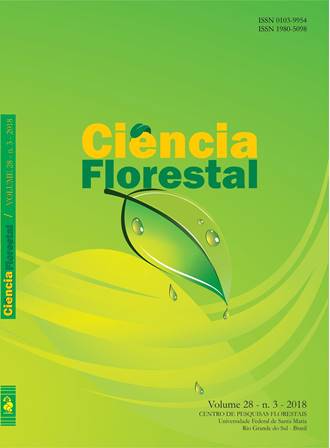BIO-ECONOMIC TRAJECTORY OF THE MANAGEMENT REGIMES IN<i> Pinus taeda <i>L. STANDS
DOI:
https://doi.org/10.5902/1980509833357Keywords:
density, management, economy, thinning.Abstract
The work study the relationship of density and diameter in Pinus taeda L. stand aiming to determining the diagram density management and describe the average-diameter trajectory in different management regimen with biologic and economic repercussion. For that, experimental growth-data measured periodically until 18 years was used. Results demonstrated that the Tang model of density and diameter predicts the maximum line efficiently, using to delimit the concurrence zone that predicted the average diameter among different population densities, as well as determine the objective diameter of the optimal management regimen to conduce the stand. The economic analysis showed a maximum present net value of 15.587,60 R$.ha-1 and 708,50 R$.ha-1.year-1 at management regimen with three thinning at 9, 13 and 18 years and final cut at 22 years. The comparison of the management regimen after equal-horizons of plan in 28 years, showed the same management regimen with the maximum economic efficiency with annual equivalent value of 1.253,40 R$.ha-1.year-1 and a maximum internal rate of 14,83 % per year.
Downloads
References
ARCHIBALD, D. J.; BOWLING, C. Jack pine density management diagram for boreal Ontario. [s. l.]: Northeast Science & Technology, 1995. 19 p.
CELLINI, J. M. et al. Modelos de perfil de tronco en Nothofagus pumilio (Polp. et Endl.) Krasser y su utilización en el cálculo del volumen total. Investigación Agraria, Sistemas y Recursos Forestales, Madrid, v. 11, p. 245-261, 2002.
DEAN, T. J.; JOKELA, E. J. A density-management diagram for slash pine plantations in the lower coast plain. Southern Journal of Applied Forestry, Washington, v. 16, p. 178-185, 1992.
DEL RIO, M. et al. Analysis of diameter-density relationships and self-thinning in non-thinned even-aged Scots pine stands. Forest Ecology and Management, Amsterdan, v. 142, p. 79-87, 2001.
DREW, T. J.; FLEWELLING, J. W. Some recent Japanese theories of yield density relationships and their application to Monterey pine plantations. Forest Science, Bethesda, v. 23, p. 517-534, 1977.
FARO, C. Elementos da engenharia econômica. 3. ed. São Paulo: Atlas, 1979. 328 p.
GINRICH, S. F. Measuring and evaluating stocking and stand density in upland hardwood forests in the central states. Forest Science, Bethesda, v. 13, p. 38-53, 1967.
HARRINGTON, T. B. Silvicultural approaches for thinning Southern Pines: method, intensity and timing. Georgia: University of Georgia, 1997. 17 p.
LONG, J. N.; SMITH, F. W. Relation between size and density in developing stands: a description and possible mechanisms. Forest Ecology and Management, Amsterdan, v. 7, p. 191-206, 1984.
MOTTA, F. S. et al. Zoneamento agrícola do Rio Grande do Sul e Santa Catarina: normas agro-climáticas. Pelotas: Ministério da Agricultura, 1971. 80 p.
OSAWA, A.; ALLEN, R. B. Allometric theory explains self-thinning relationships of mountain beech and Red pine. Ecology, Washington, v. 74, n. 4, p. 1020-1032, 1993.
PALAHI, M. et al. Stand-level yield model for scots pine (Pinus sylvestris L.) in north-east Spain. Investigación Agraria: Sistemas y Recursos Forestales, Madrid, v. 11, n. 2, p. 409-424, 2002.
REID, R. Silvicultural management of Australian blackwood (Acacia melanoxylon) in plantations and multi-purpose forests. In: GOVE, J. H. Structural stocking guides: a new look at an old friend. National Research Council Canada, Ontario, v. 34, n. 5, 2004.
REINEKE, L. H. Perfecting a stand-density index for even-aged forests. Journal of Agricultural Research, Washington, v. 46, p. 627-638, 1933.
REZENDE, J. L. P; OLIVEIRA A. D. Análise econômica e social de projetos florestais. Viçosa, MG: UFV, 2001. 389 p.
SANTA CATARINA. Gabinete de Planejamento e Coordenação Geral. Atlas de Santa Catarina. Rio de Janeiro: Aerofoto Cruzeiro, 1986. 173 p.
SAS INSTITUTE. SAS/STAT user’s guide. Version 8 (computer manual). Cary: SAS Institute, 1999.
SAUNDERS, M. R.; PUETTMANN, K. J. A preliminary white spruce density management diagram for the lake states. Minnesota: University of Minnesota, 2000. 13 p.
SCHNEIDER, P. R. Betriebswirtschafliche und estragskundliche Grundlagen der Forsteinnrichtung in Südbrasilien am Beispiel von Pinus elliottii. 1984. 190 f. (Tese de Doutorado) - Albert-Ludwigs-Universität, Freiburg, 1984.
SCHNEIDER, P. R.; SCHNEIDER, P. R. Introdução ao manejo florestal. Santa Maria: UFSM, 2011. 348 p.
SMITH, D. J.; WOODS, M. E. Red pine and white pine density management diagrams for Ontario. Tech. Rep. n. 48. Sault Ste. Marie: Ontario Ministry of Natural Resources, South Central Sciences Division, 1997. 31 p.
SMITH, N. J.; HANN, D. W. A growth model based on the self-thinning rule. Canadian Journal of Research, New Westminster, v. 16, p. 330-334, 1986.
SPEIDEL, G. Betriebswirtschaftliche. Hamburg: Paul Parey Verlag, 1967. 189 p.
STERBA, H.; MONSERUD, R. A. The maximum density concept applied to uneven-aged mixed-species stands. Forest Science, Bethesda, v. 39, n. 3, p. 432-452, 1993.
TANG, S. et al. A growth and self-thinning model for pure even-age stands: theory and applications. Forest Ecology and Management, Amsterdan, v. 70, p. 67-73, 1994.
TANG, S. et al. The impact of initial stand density and site index on maximum stand density index and self-thinning index in a stand self-thinning model. Forest Ecology and Management, Amsterdan, v. 75, p. 61-68, 1995.
WEST, P. W.; BOROUGH, C. J. Tree supervision and the self-thinning. Rule in a monoculture of Pinus radiate D. Don. Annuals of Botany, Oxford, v. 52, p. 149-158, 1983.
WESTOBY, M. The place of the self-thinning rule in population dynamics. American Naturalist, Lancaster, v. 118, p. 581-587, 1981.
YODA, K. et al. Self-thinning in over rowed pure stands under cultivated and natural conditions. Journal Biology, Osaka, v. 14, p. 107-129, 1963.
ZEIDE, B. Analysis of the 3/2 power law of self-thinning. Forest Science, Bethesda, v. 33, n. 2, p. 517-537, 1987.
ZEIDE, B. Self-thinning and stand density. Forest Science, Bethesda, v. 37, n. 2, p. 517-523, 1991.
ZEIDE. B. Tolerance and self-tolerance of trees. Forest Ecology and Management, Amsterdan, v. 13, p. 149-166, 1985.







